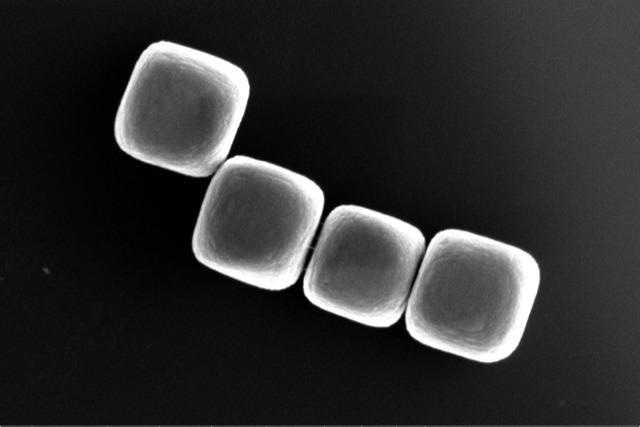Reviewed by Alex SmithMay 30 2022
At the Delft University of Technology (TU Delft), researcher Laura Rossi and her team have come up with a new approach to designing synthetic materials out of tiny glass particles — colloids.
 Four cubic colloids made from glass. Image Credit: Delft University of Technology.
Four cubic colloids made from glass. Image Credit: Delft University of Technology.
In a joint partnership with their collaborators from Queen’s University and the University of Amsterdam, the researchers showed that they just simply utilize the shape of such colloids to create interesting building blocks for new materials. This is irrespective of other properties of the colloidal particles.
Rossi stated, “This is striking, because it opens up a completely new way to think about materials design.”
The study has been recently reported in the Science Advances journal.
Colloids are small particles, ranging from a few nanometers to a few microns in size. They include a collection of molecules and can possess various properties based on the material they are made up of.
Under certain circumstances colloids can behave like atoms and molecules, but their interactions are less strong. That makes them promising building blocks for new materials, for example for interactive materials that can adapt their properties to their environment.
Laura Rossi, Researcher, Delft University of Technology
New Way of Materials Design
The cube-shaped colloids made from glass have the potential to self-assemble into simple structures like twisted hexagonal and cubic lattices if left alone.
However, rather than going instantly from the building block to the final structure, the scientists took small groups of colloids and integrated them into bigger building blocks. While these clusters of colloids are being assembled, the result obtained was a different final structure possessing diverse material properties compared to the self-assembled structure.
From a chemistry point of view, we always focus on how we can produce a certain type of colloid. In this study, we’ve shifted our focus to: how can we use the colloids that are already available to make interesting building blocks?
Laura Rossi, Researcher, Delft University of Technology
A Step Forward
Rossi and her collaborator Greg van Anders feel that one of the primary aims of their research community is to devise complicated colloidal structures on request.
Rossi stated, “What we found here is very important, because for possible applications, we need to have procedures that can be scaled up, which is something that will be hard to achieve with most currently available approaches.”
Van Anders added, “The basic ability to pre-assemble identical pieces from different building blocks, and have them make the same structure, or to take the same building block and pre-assemble different pieces that make different structures, are really the basic ‘chess moves’ for engineering complex structures.”
Even though Rossi studies the basic concepts instead of the applications of materials design, she has the ability to visualize final applications for this particular work.
Rossi stated, “We found that the density of the structure that we prepared was much lower than the density of the structure you would obtain by using the starting building blocks. So you can think about strong but lightweight materials for transportation.”
Teaming up
As soon as clusters of colloids were fabricated by the Rossi’s team in the laboratory, they relied on the team from Queen’s University to build the eventual structure out of pre-assembled clusters with a computer simulation.
With these kinds of projects, it’s great to be able to team up with others who can run simulations, not only to understand what’s happening in depth, but also to test how big the chance of a successful lab experiment will be. And in this case, we got very convincing results that we were understanding the design process well and that the resulting material can be useful.
Laura Rossi, Researcher, Delft University of Technology
The next step will be to build the final structure composed of the groups of colloids in the laboratory.
Rossi stated, “After seeing these results, I’m confident that it can be done. It would be great to have a physical version of this material and hold it in my hand.”
Journal Reference:
Baldauf, L., et al. (2022) Shape and interaction decoupling for colloidal preassembly. Science Advances. doi.org/10.1126/sciadv.abm0548.